
Logos 7 Review

Logos 7 is a vast scholarly library tied together into a single tool that gives you quick access to commentaries, word studies, lexicons, reference works, the original languages, and media resources. With Logos 7 you can study the Bible on a seminary level. Quickly see commentary from ancient writings or modern scholars. It does research in minutes that would take weeks to do by hand the old fashioned way. The new features in Logos 7 provide sermon prep and study tools that I can’t live without.
Click here to buy Logos 7 and you’ll get a
15% discount during the launch period and an extra book for Logos 7 called 300 Quotations for Preachers.The launch promotion is over but this link will still get you the current promotion (discount and/or bonus content) and will help Bible Buying Guide with a small commission on your purchase.
Logos 7 is not meant to take the place of Bible study. Instead it’s meant to streamline that study – to take away all of the wasted time of flipping through books giving you more time to focus on God’s Word and the study resources. Logos 7 is a connected library. It seems that every word and topic in every book are connected together.
Logos 7 is made up of two parts:
- A theological library with ancient writings, reference works, commentaries, dictionaries, current works
- A features set with research tools to searches the library
Logos searches through thousands of books and tools to bring in the relevant information. Tools include:
- Bibles
- Original languages
- Notes, color coding, etc.
- Dictionaries
- Commentaries
- Books
- Concordance
- Atlas
- Topical lists
- Cross references
- Video
- Images
- Journal
Tools that are new to Logos 7 include:
- Audio Books
- New Daily Study Bible
- Tyndale’s commentary
- Hodges Systematic Theology
- On the Incarnation by Athanasios audio book
- Orthodoxy audio book
- Anchor Bible Dictionary
- Ancient Christian Commentary on Scripture
- Preaching the Psalms
- The Bible Speaks Today New Testament Commentary
- The Pillar New Testament Commentary
The tools work together to make your study time more efficient and productive. Everything is tied together to save you time in researching a topic or verse. The results of your studies are sharable. You can even build presentations and sermons.
I’ve been using Logos 7 for a few weeks and I love the new features. In this review I’ll take a look at those features.
What’s New in Logos 7
There are various features based on the level you buy. I have the Gold Edition. Although there are a lot of new features, my favorite is the one that has single-handily solved a problem that I’ve spent a lot of time trying to solve – let’s look at the Sermon Editor.
Sermon Editor

Sermon Editor is the perfect sermon-creating tool for preachers, teachers, and even small group leaders. It includes all of the tools you need in one place: study tools, the Bible, a word processor, and presentations. This saves a lot of time from going back and forth from one tool to another and having to copy and paste.
I’ve always been intrigued by the sermon building process. We all have our methods and mine has developed over time. I started with pencil and paper and I would jot down major points and references, creating an outline. I went from that to creating outlines in Word. Since I make my living as a writer it seemed natural for me to write my sermons out as manuscripts. I would print them out and make notes with pencil. After that I started preaching from a laptop and then eventually I scaled it down to a tablet.
My process uses a Bible app and I write and paste into Word. I then convert that to the Kindle format. It works great for me but I want to use one app for everything. The sermon editor is a game-changer. This lets you prepare your sermon and write it as notes or a manuscript if you want. We all have our methods and this fits mine perfectly.
You can use an outline from the Sermon Starter and even create handouts and slides for your presentation automatically. I currently don’t use a screen to display video but I do use a tablet for my notes. With this feature I can build the sermon as a presentation to use to preach from.

You can type a reference and it brings in the verse for you and will even create a slide. I’m used to highlighting and copying the Scripture, switching windows, and pasting the Scripture into Word. Sermon Editor will save a lot of time. You can send it to Proclaim, Faithlife TV, or Powerpoint and share with your iPad. You can also create quizzes, handouts, study questions, and more. It even gives an indication of how long the sermon will be.
Easily insert prompts into your notes to help you know the next step you wanted to take. For example, a prompt could tell you to have the congregation to turn to a specific passage. Quickly and easily add quotes from any of the resources in your library. A Question tools will highlight questions so they stand out. It creates slides for you as you build your sermon. It has lots of slide designs to choose from and includes verse art, media, and illustrations. When you’re ready you can export your sermon to Powerpoint.
Exporting to Powerpoint is just a matter of clicking the button. You can also use the Print/Export feature to save the file as other formats such as RTF, text, HTML, Word, and more. I love being able to use Word. I’m a writer and this is perfect for writing books and articles. If you sync with mobile your sermon will appear under Documents.
Of all the tools I’ve used the Sermon Editor is by far the best tool for developing and presenting sermons. I can’t describe how excited I am with the Sermon Editor. Stay tuned to BBG for a detailed tutorial.
More Mobile Ed Content
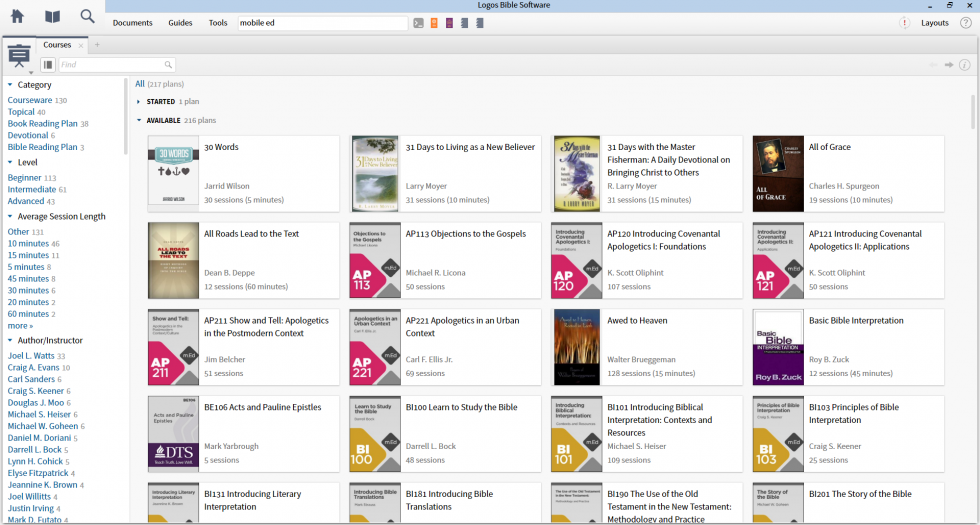
These are Bible courses from prominent teachers and include daily readings, assignments, and more. It includes lots of topics, books, famous authors, etc. There is lots more mobile ed. content than before. There are currently 217 courses but the number you have access to will vary depending on the edition you buy.
They are sorted by category, level, average session length, author or instructor, Bible passage, biblical people, biblical things, biblical concepts, and preaching themes. You can study the sessions at your own pace and it keeps track for you. Some include video while others are text.
New Panel View
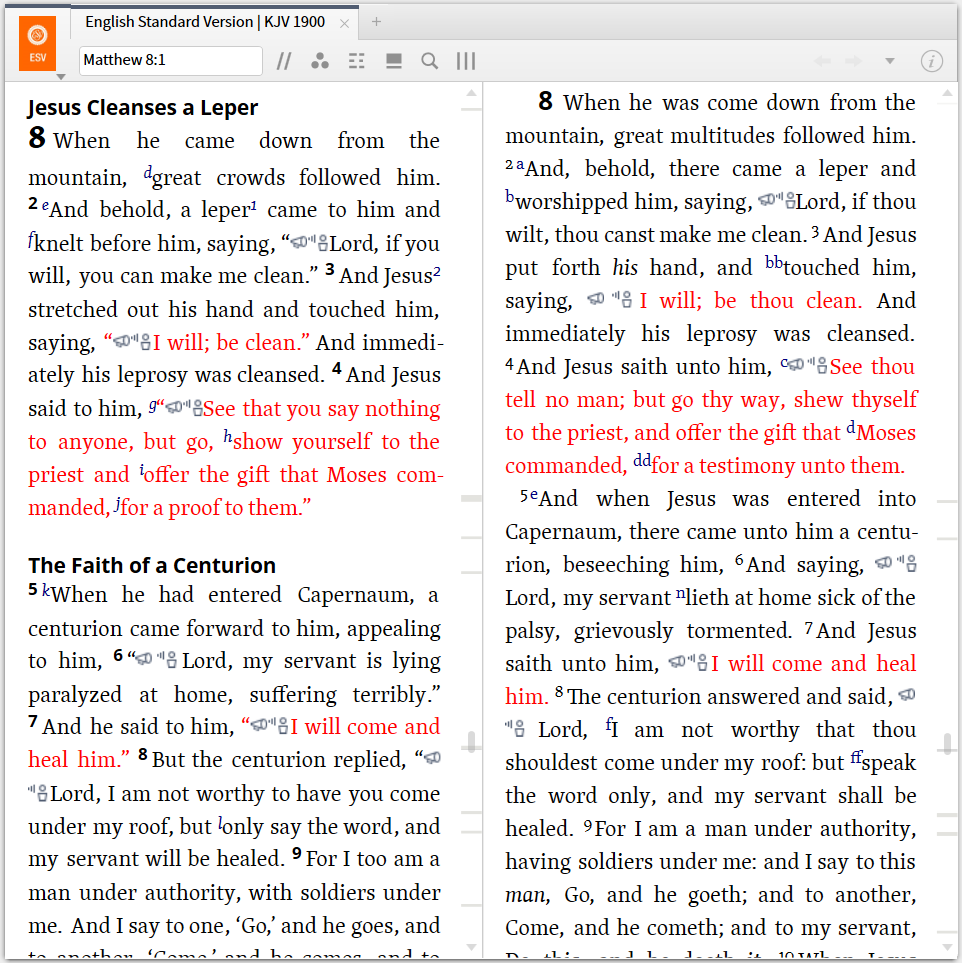
The panel view lets you tie panels together to streamline the study process. This lets you narrow your focus to just a few tools. The window on the right can be moved independently but will sync with the window on the left as you navigate with it. It still shows the Greek or Hebrew words with Strong’s numbers in the footer and you can use the search tools as normal.
New Layout Templates
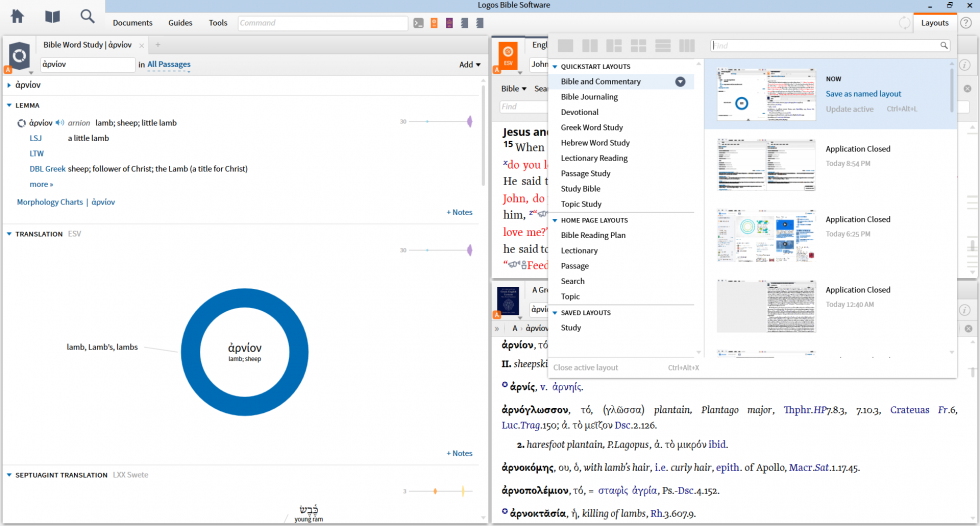
The New Layout Templates are another of my favorite features. You can create new layouts for any purpose but these go even further by providing premade layouts for you that focus on a specific usage. Layouts include devotions, word studies, book studies, reading, etc.
Quickstart layouts include:
- Bible and Commentary
- Bible Journaling
- Devotional
- Greek Word Study
- Hebrew Word Study
- Lectionary Reading
- Passage Study
- Study Bible
- Topic Study
Homepage layouts include:
- Bible reading plan
- Lectionary
- Passage
- Search
- Topic
These save a lot more time than I expected. It’s easy to switch back and forth between them. You can also use them as a template to create your own layouts to save and reuse. The layouts make great use of space and tools and they’re already linked together. Here are a few of the layouts:
Passage Layout
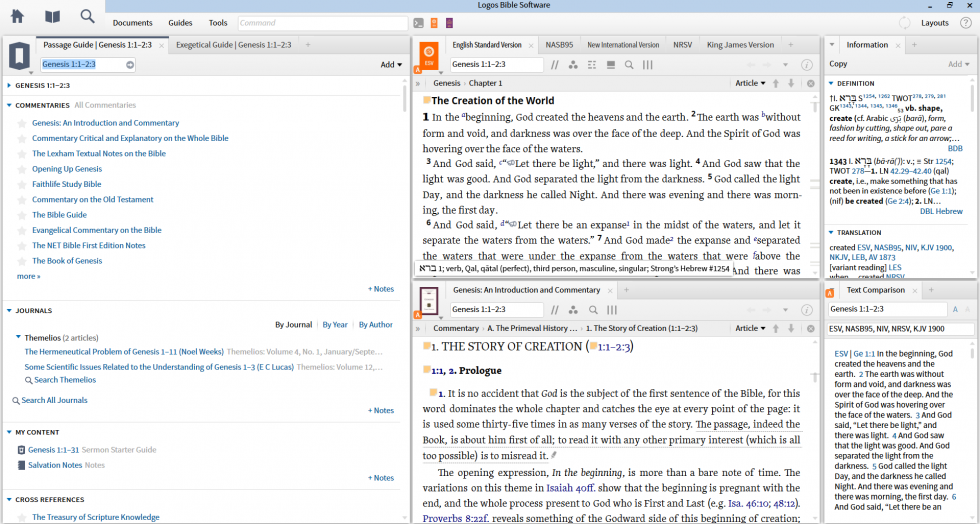
This is the Passage layout. It’s one of my favorites and as you can see there is a lot of things open and they’re all tied to the same link set. This would have taken me several minutes to open and set the link set if I had done this manually.
I actually prefer to see more of the Scripture on screen. This is no problem to change. I just grabbed the Bible tab and moved it until the section of the screen I wanted it to cover was highlighted and dropped it there. This added the Bible and the commentary to the same window with each one having its own tab.
Greek Word Study

The Greek Word Studies includes word studies, my preferred Bible, and a Greek-English Lexicon.
Hebrew Word Study
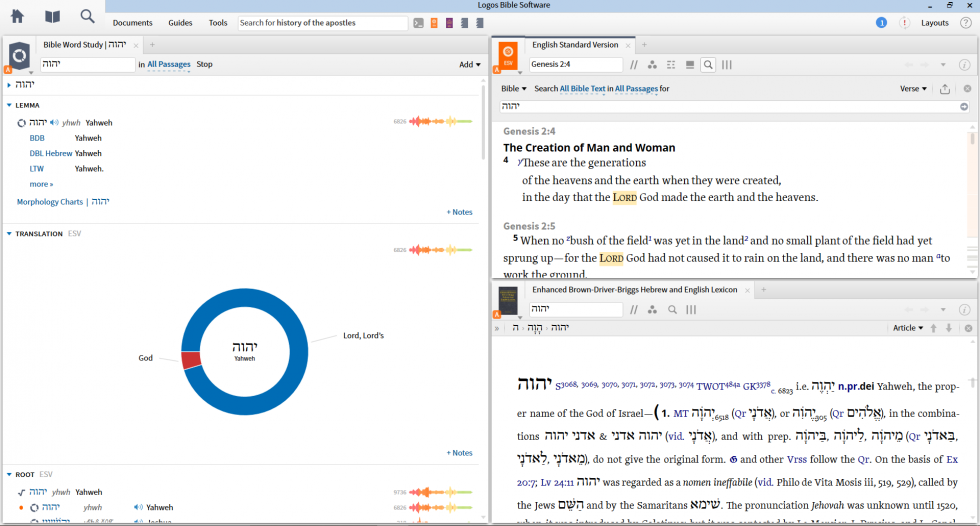
The Hebrew Word Studies include word studies, my preferred Bible, and Enhanced Brown-Driver-Briggs Hebrew and English Lexicon.
Devotional
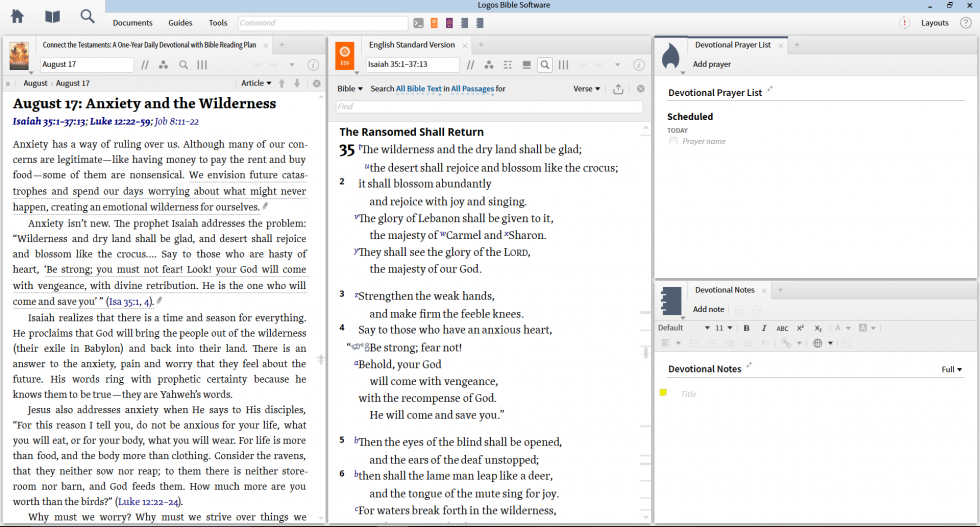
The Devotional layout includes a daily devotional with reading plan, my preferred Bible, devotional prayer list, and devotional notes.
Study Bible
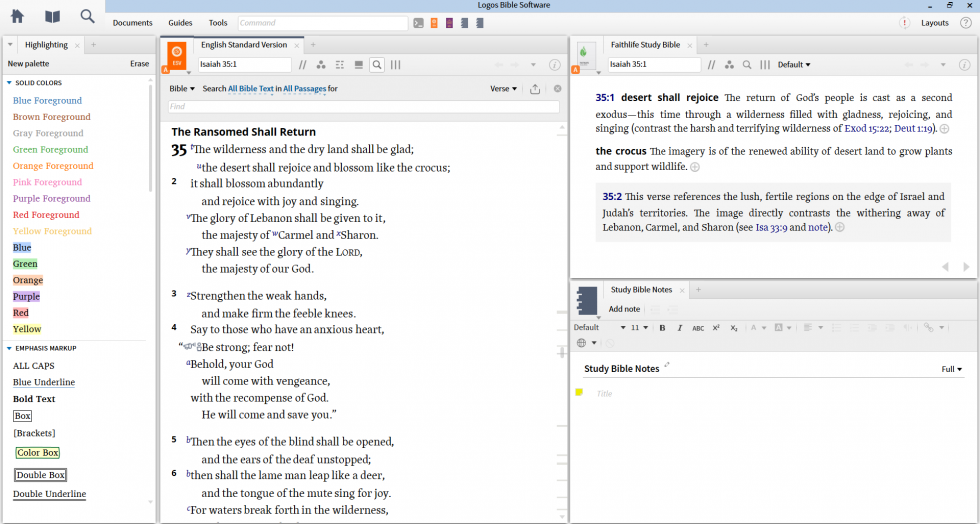
The Study Bible layout loads the highlighters, my preferred Bible, the Faithlife Study Bible notes, and Study Bible Notes where I can write my own notes.
Topical

Topical includes the Factbook, my preferred Bible, and the Lexham Bible Dictionary.
Bible Journaling
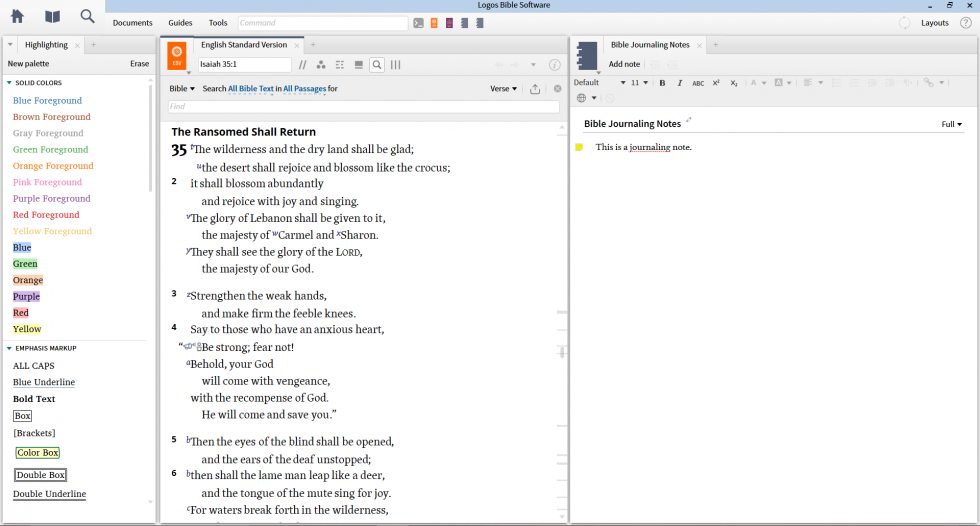
Bible Journaling includes the highlighters, my preferred Bible, and a journaling notebook. I can see me using this one a lot.
New Interactives

There are several new interactives that include detailed information for you to explore. Here’s a quick look at each.
In the Tomb lets you explore exactly what a first century tomb is like. It includes commentary from Dr. Craig Evens, archaeological information, and devotional content
New Testament Use of the Old Testament shows how and where the New Testament draws on the Old Testament.
Names of God lets you browse by name, passage, etc., and helps you learn the significance of each name.
Speaking to God shows all of the passages where someone is speaking to God. It shows the speaker, book, context, distance, mode, content, place, and lots more. It shows how people would speak to God throughout the Bible.
Biblical Manuscripts shows the various manuscripts along with writing tools and methods.
Media Tool
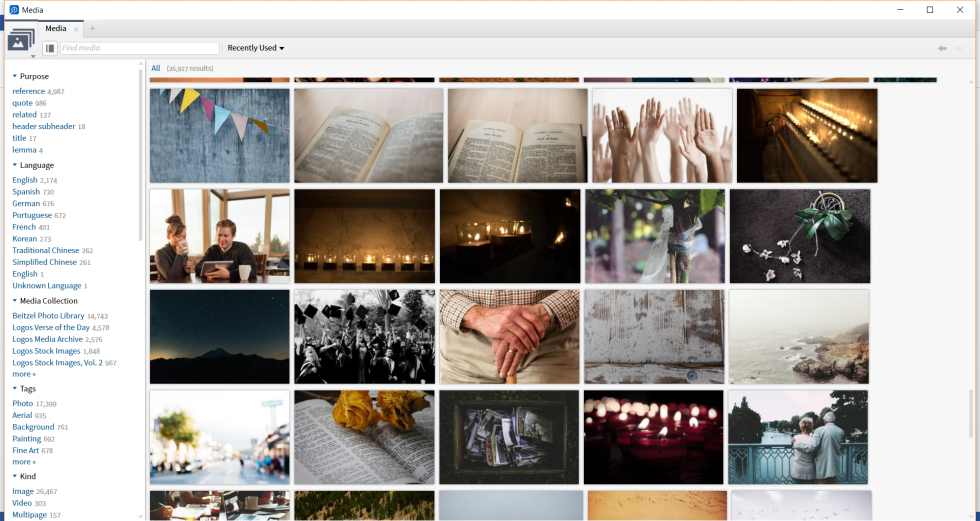
This makes finding and editing media much easier. It has almost 27,000 results and has media categorized by purpose, language, media collection, tags, kind, author, biblical people, biblical places, biblical things, biblical events, biblical concepts, preaching themes, and universal timelines.
I love selecting the reference (under the purpose category) and just browse through all of the Scripture slides. There are lots of photos, paintings, videos, and lots more. I’d be surprised if you couldn’t find the stock images you needed for you presentation.
The media tool makes it easy to search, edit, copy, save, sent to Proclaim or Powerpoint, print, and share on social media. Images can be saved as several file types and are in various sizes.
Theology is Reorganized
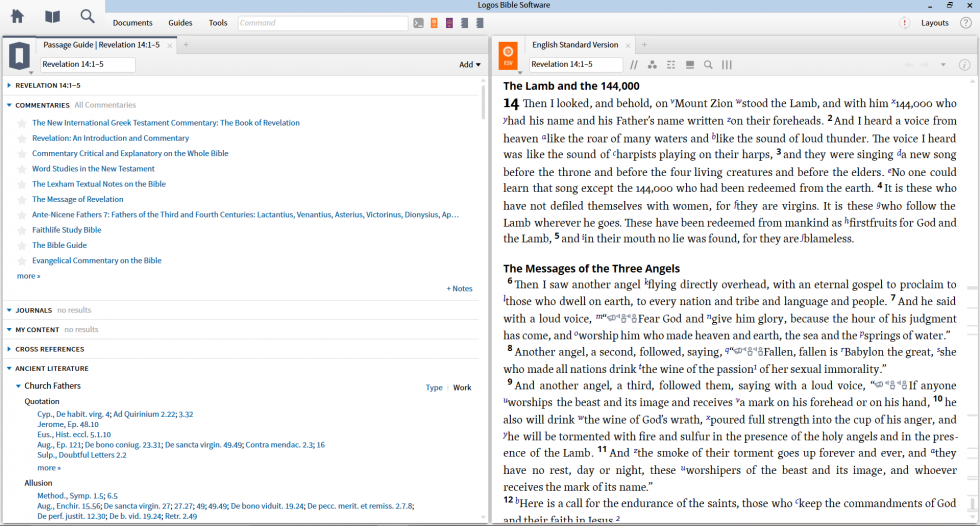
Biblical and systematic theology tools have been reorganized around passages. This makes it easier to find who has commented on a particular passage and what their perspective was, and their point in history. I love the organizational structure. It’s easy to navigate and hide anything you’re not interested in. You can click on what you want and it opens a new tab for easy use.
Text Comparison

The text comparison tool has been upgraded to make the comparisons more clear. It even helps you discover what passages you should be looking at. It shows multiple translations together so you can easily see the differences and it gives the percentage difference of each translation from your preferred translation.
Concordance
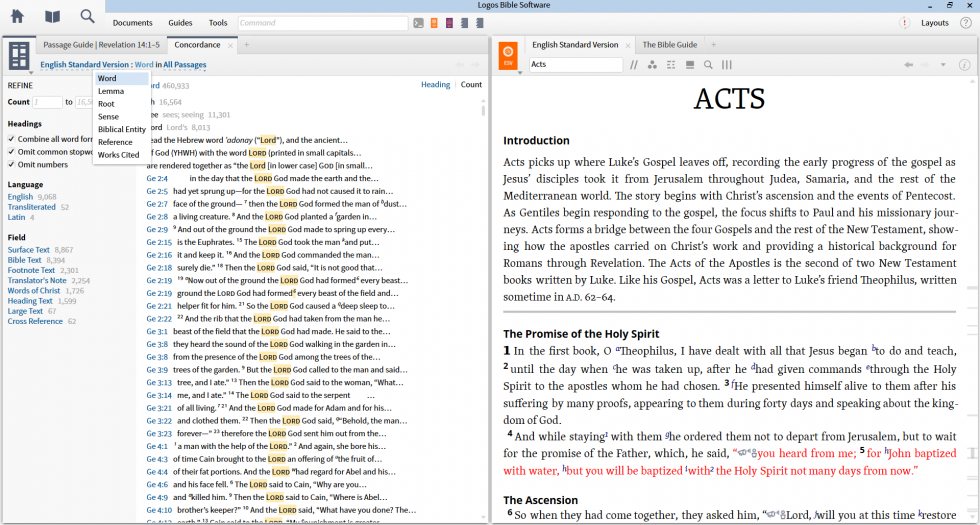
The concordance brings in words, the original languages, the roots, the biblical sense, etc. You can narrow your focus to the type of text, part of speech, who is talking, and more. It even brings in the analysis of the meanings of the words and shows how many times the word is repeated.
You can also have it to search lemma, root, sense, biblical entity, references, or works cited. Sort by word or by count, and analyze complete books, passages, or even a group of texts.
When generating the concordance it automatically starting building the concordance in my preferred translation. This took a few minutes and it found 460,933 words. Now that the concordance is built it loads automatically when I click on it.
The concordance even includes footnotes, translator’s notes, section headings, etc., and each can be selected individually. View entries from the entire Bible or from common divisions such as Old Testament, Major Prophets, Johannine Epistles, etc. You can also search commentaries.
The concordance tool makes excellent use of the fact that Logos 7 is a digital library. This is definitely not your grandfather’s concordance.
Logos Now

You can expand Logos 7 through Logos Now. This is a membership subscription service that releases new features every 6 weeks. Here are a few of the tools you’ll get with Logos Now:
Bible Browser
The browser lets you explore. This is great for when you don’t know what you want to find or if you just want to look and see what’s available. It includes:
- Books
- People
- Places
- Things
You can click on these and then filter them down to as much detail as you want.
Lemma and Passage
Lemma and Passage identifies words that are talked about the most in the commentaries and what they say.
Using Logos 7
At first Logos 7 can feel overwhelming. It doesn’t look like a Windows app so the common menus I’m used to are not here. This creates a little bit of a learning curve but it also creates a layout and tools that work the way they need to and they can adjust to any need. It comes with lots of introductory videos and it isn’t that hard to learn. Even if you’ve never used Logos before you can be using Logos 7 in just a few minutes of installing it. Of course the complex features will take longer but it’s time well-spent.
Logos 7 is a large program and it’s hard to talk about everything in a single article. I will publish more articles in the future to go through the various features. Until then, here are some of the older tools that I found useful.
Home and Help
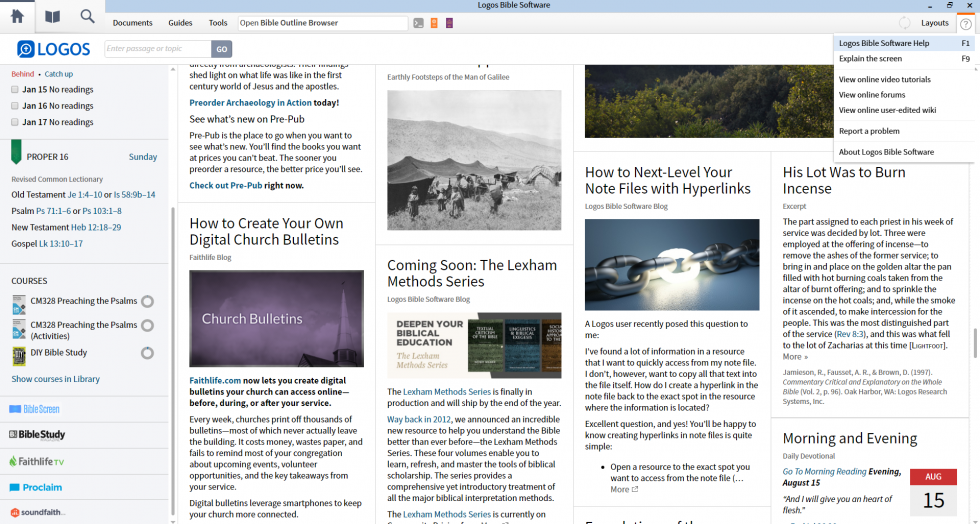
I love opening the program and browsing what’s on screen in the home page. This always includes a Scripture with a graphic, links to blog posts, devotionals that open in Logos 7, videos online, archaeological images, and much more. This is basically a blog with lots of tutorials and articles.
In the upper right corner is a question mark. This opens a drop-down menu with links to help files. If there’s a feature you want and you can’t find it I recommend searching the blog as there are lots of tutorials there.
Taking Notes

There are lots of ways to take notes in Logos including individual verse notes, devotions, sermons, journal, and more. Even references within my notes are clickable. If you hover your mouse over a reference you’ll get a popup with the verse on screen. You can hold ctrl + click if you want to go to the verse. It can even understand abbreviations. Your own notebook is just a click away. Create a note for any verse and that note can appear within a notebook that you choose.
Searching

Logos has always had some powerful search features. It can search your vast library for any topic or word. It even indexes my own books and includes them in the search results.
Bible Text Only
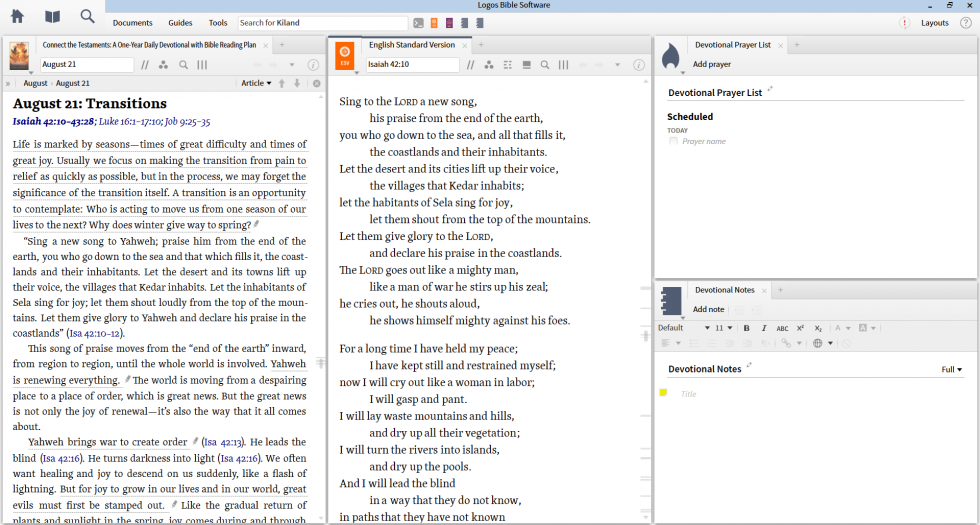
One of my favorite features is the visual filter that shows Bible text only. This turns off the chapter and verse numbers as well as the section headings, cross-reference keys, and footnote indicators – giving you just the biblical text in a beautiful and readable format.
You can still select a verse with your cursor to see the chapter and verse number in the search box if you want, and you can see the Strong’s numbers and definition in the footer. This has been my morning reading method since I got the Logos 7 (this feature started with Logos 6) beta and I’ll continue this for quite a while.
You’ll notice that I’ve mostly used the ESV (I also used the KJV in paragraph quite a lot too). Currently the ESV is 2011 rather than the 2016 Permanent Text Edition. I’m sure that will change soon.
QuickStart Videos
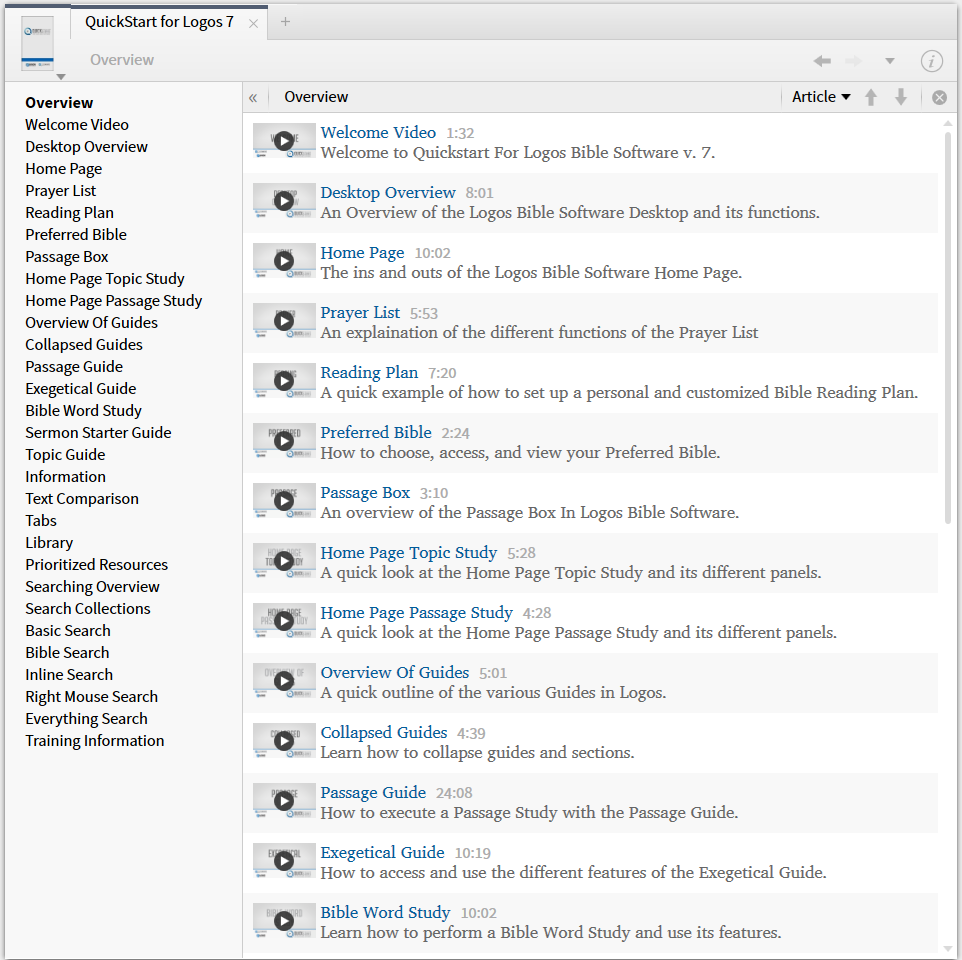
There are 30 videos to get you started with Logos 7. They cover the basics well enough that you can be using Logos 7 quickly and you can reference the videos any time you need. They don’t go into a lot of depth but it’s enough to get you going in the right direction. I highly recommend watching them.
Performance
The program is huge and can take a while to download on slower connections. I used a 4g Wi-Fi connection and had it installed and running in around 1.5 hours. After the install it wants to index, which will take all the power you can give it for around 30 minutes. Once the program was installed it never had any issues with running or slowing down. All searches were done within seconds (usually single digits).
For the record I’m running this on an Asus laptop. My specs include:
- Windows 10
- 4ghz i7
- 8gb RAM
- Geforce 940m
Upgrading
If you already own a Logos package then new resources will be added to your library and dynamic pricing. This will make sure you’re not paying for a resource you already own.
Get a Discount and a Free Book
If you use our link to buy Logos 7 you’ll get a 15% discount during the launch period and an extra book for Logos 7 called 300 Quotations for Preachers.

I chose that book specifically because it helps to understand the development of doctrine when you see what preachers were thinking at a certain time in history. Also, even if you disagree with them it helps to have quotes for teaching and preaching as well as for your own study.
After the launch period the discount will never by 15% again, so this is the best opportunity to get the best price. If you’re not sure if Logos 7 is right for you, you can return it within 30 with no questions asked.
Conclusion
Logos 7 is not a simple program. It’s a powerful Bible research tool that links hundreds of dictionaries, commentaries, courses, books, media, the original languages, and more together to create the vastest digital Bible library available. What makes Logos so useful is how all of the resources are linked.
The libraries do include doctrine geared toward specific groups. A lot of the tools are commentaries, so a look of the study results will be someone else’s opinion about a word or topic. I don’t always need commentary on Scripture. I prefer to allow Scripture to interpret itself rather than relying on what other’s believe. With that said, commentaries are useful and this is by far the easiest way to access them.
Of course there’s a lot more here than commentaries. The tools I need to study the Scriptures themselves without relying on commentary is here too – references, dictionaries of people, places, things, words, the original languages, topical lists, etc., are here and linked together.
Logos 7 is a professional level program. It’s complicated and takes a long time to master. You’ll pick it up much faster if you watch training videos and attend webinars. It’s time well spent. The time you’ll spend learning to use Logos 7 will pay you back exponentially.
Also, Faithlife gives a free book every month, and discounts on other books. The have free books, monthly sales, and specials.
Although Logos 7 is an expensive program it’s worth every penny. I highly recommend the Logos 7 Gold Edition for layman who want to dig deeper into God’s Word, students, scholars, preachers and teachers who develop sermons and coursework, and pastors that want a serious Bible study tool. If you’re looking for a high level of resources and powerful tools, Logos 7 is the program you want.
Click here to buy Logos 7 and you’ll get a 15% discount during the launch period and an extra book for Logos 7 called 300 Quotations for Preachers.
Faithlife provided this software free for review. I was not required to give a positive review – only an honest review. My opinions are my own.

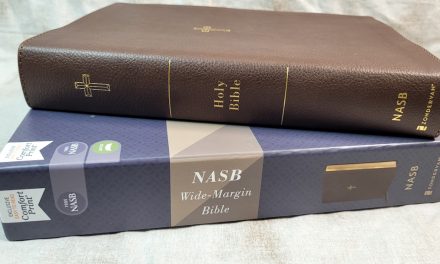
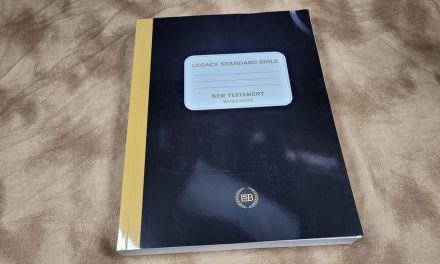

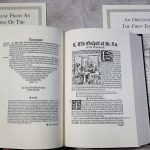
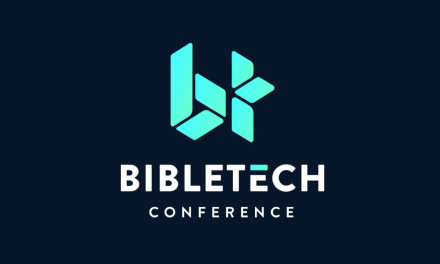


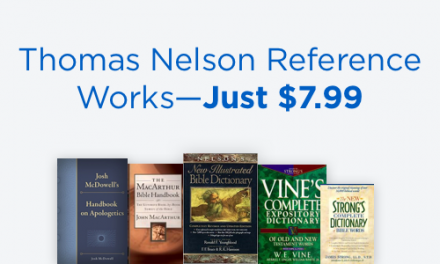



Trackbacks/Pingbacks